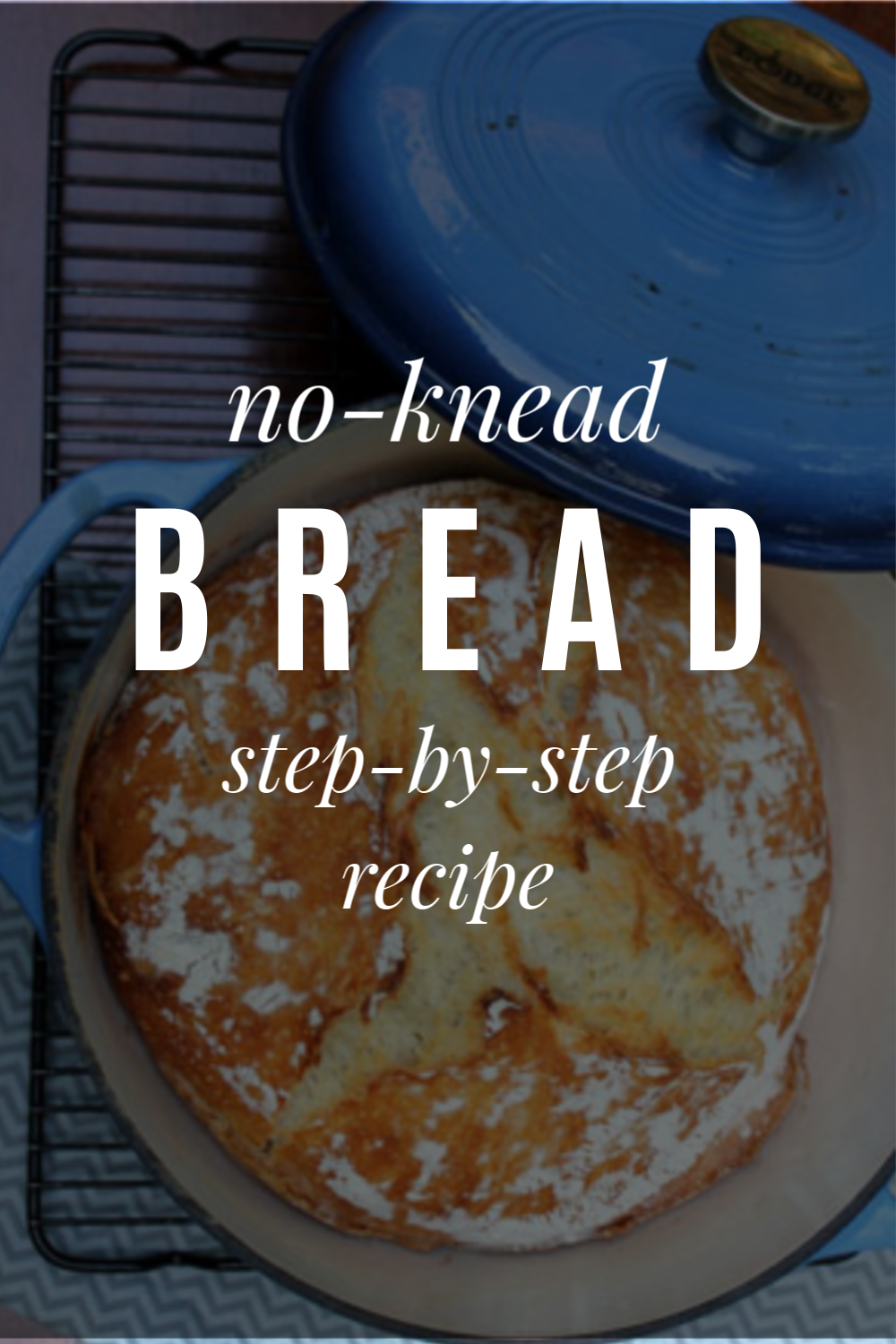
No-Knead Bread Recipe
If you have been hanging out around Frugal Living NW for awhile, you know that I am a big believer in making food from scratch at home. With a few exceptions, I prefer creating something in my own kitchen to buying it in the grocery store.
Bread can be tricky, though. There is some stiff competition out there, and it is tough to replicate a commercial oven’s heat and steam in a normal home kitchen.
For the last several years, I thought that Artisan Bread in 5 Minutes was the best thing since, well, sliced bread. It was simple, and we were content with the results. That is, until last summer when our neighbor brought over a beautiful, delicious loaf of home-baked bread. We had to know her secret. One phone call, and she came back with the book, My Bread by Jim Lahey (Amazon).
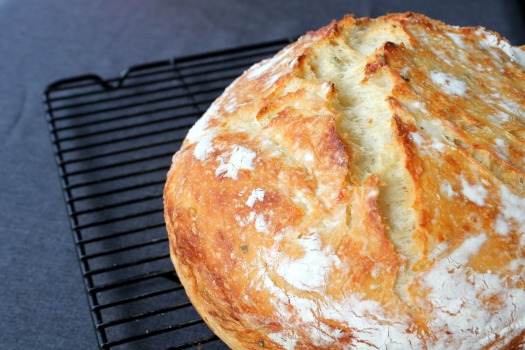
We have been baking bread using this method ever since. I can count on one hand the number of times I have bought bread in the store since then, because I can now make an artisan-quality loaf at home for a fraction of the cost.
I am telling you, this is consistently the best bread I have ever made in my kitchen. Okay, enough gushing. Let’s make some bread.
The only changes I have made to Lahey’s method is to double the amounts and adjust the baking time and temperature to achieve a bigger loaf with a thinner crust.
Oh, and don’t be put off by all these steps. This is totally possible for home bakers at any skill level. I wanted to give you the confidence to do this on your own. A concise recipe can be found at the bottom of this post.
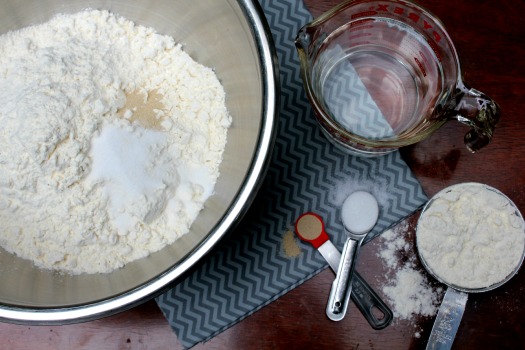
The ingredients are simple: flour, water, salt, and yeast. My husband calculated this bread costs 74¢ per loaf (using Bob’s Red Mill flour & Costco yeast).
Oh, wait! Don’t forget to factor in the roughly 8 cents of energy used to bake it for an hour. No, I’m serious. My husband really does think about this stuff! He’s funny.
So, there you go. A whopping 81¢ for a substantial 2.5 pound loaf of bread. That is crazy cheap.
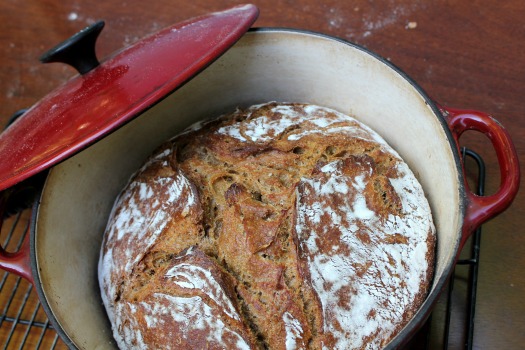
If you want to use some whole wheat flour, substitute 3 cups of whole wheat for 3 cups of the all-purpose flour (3 cups whole wheat and 3 cups of unbleached flour for a total of 6 cups) and add 3 Tablespoons of molasses (optional). This will produce a slightly sweeter, denser loaf of bread. Delicious.
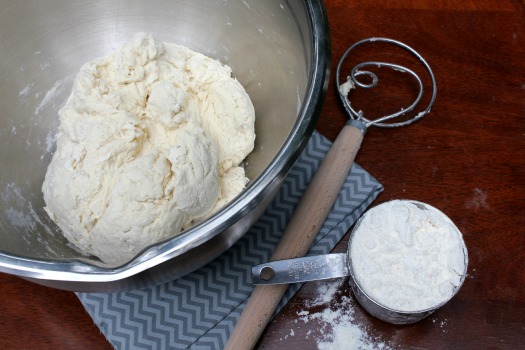
Combine the dry ingredients, add the water, and stir to combine (the funky looking wood-handled item is the amazing Danish Dough Wisk — makes stirring stiff dough a snap). The dough should be wet and sticky. Depending on the temperature and humidity in your home, you may need to add a little more flour or water, 1 Tablespoon at a time. So far, these steps are exactly the same as the 5 Minute method.
The main differences are that you use significantly less yeast (1/2 teaspoon vs. 1 1/2 Tablespoons) and significantly more initial rise time (12-18 hours vs. 2 hours).
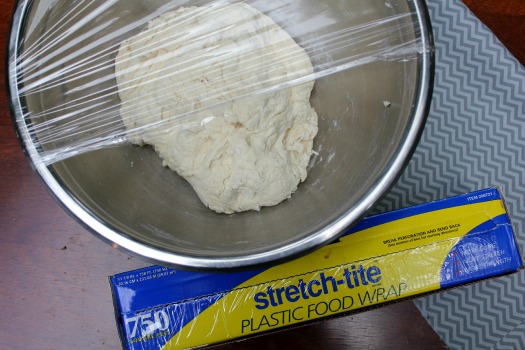
Once the ingredients are completely combined, cover the bowl with plastic wrap and leave it on the counter to rise for 12-18 hours. This slow rise aids in the fermentation of the yeast, giving the bread a better flavor.
Okay, I know what some of you are thinking: 12-18 hours! That’s ridiculous! Who has that kind of time?! I get it.
However, here are two things to consider:
- Once you get into a rhythm of baking your own bread, it’s not a big deal. I start mine in the afternoon or evening and bake it the next morning or afternoon. This would also be an easy weekend routine.
- Just like the title claims, this bread requires no kneading. It is not fussy, temperamental dough. You can produce a delicious loaf of bread with very little hands-on effort & experience.
You’ll know your dough is ready when it has risen in the bowl, smells yeasty, darkened slightly, and is covered with small bubbles.
Using well floured hands, shape and tuck the sticky dough into a rough ball. You can also fold it over a couple times on a well-floured surface. It doesn’t have to be perfect; just keep quickly tucking the dough underneath with your fingertips until you have a semi-smooth dough ball. The dough should be wet but manageable; you don’t want a wet blob so sticky that you can’t shape it into a ball.
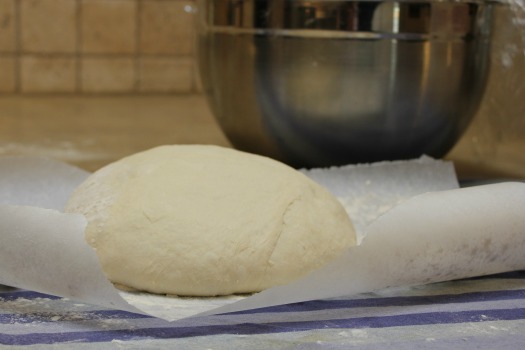
Take a clean linen or cotton tea towel (not terry cloth) and dust it with flour, cornmeal, or wheat germ to prevent the dough from sticking to the towel as it rises. You can also use a floured square of parchment paper on the towel to make the dough ball easier to handle. Place the dough ball, seam side down, in the middle and dust with more flour.
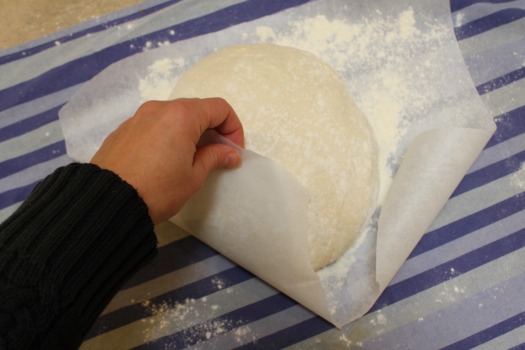
Cover the dough with the (parchment paper and) towel and let it rise for 1-2 hours at room temperature, until doubled in size. During the last 30 minutes of rise time, place a heavy lidded 6-8 quart pot, like a Dutch oven, in a cold oven and preheat it to 425 degrees.
Confession: I own three Dutch Ovens. I use them all the time. They are incredibly versatile and worth the investment. If you don’t own one, you could also make this in any lidded pot, provided it is oven-safe at such high temperatures. Also, check the knob on your pot. If it isn’t rated for such high heat, you’ll want to remove it or cover it with foil. You can also buy an inexpensive replacement knob that is rated for higher temps!
Okay, this is the trickiest part of the entire operation. Remove the lid from the piping hot Dutch Oven, slide your hand underneath the towel or parchment paper, and flip the risen dough (seam side up now) into the pot. Try to flip close to the pot or the flour will fly everywhere. Remove the towel or paper and set aside.
This might take a bit of practice, but again it doesn’t have to be perfect. Some of my worst flips have produced my most beautiful loaves. I love what Lahey writes, “…even the loaves that aren’t what you’d regard as perfect are way better than fine.”
Place the lid back on top and slide the pot back into the hot oven.
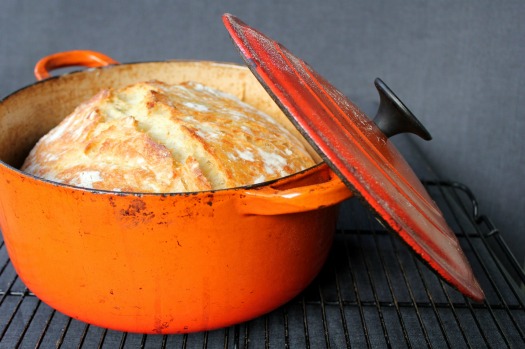
Bake it for 40-50 minutes. Remove the lid. Bake for another 5-10 minutes, until golden chestnut brown. The internal temperature should be around 200 degrees. You can check this with a meat thermometer if you’re nervous about knowing when your loaf is done.
Oh man, your house will smell so good about right now.
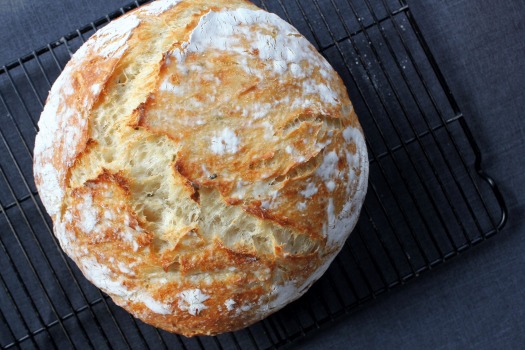
Place the loaf on a cooling rack. You will hear it crackling as it cools. Use every ounce of self-control to resist cutting into it until it is “quiet”; cutting it too soon will make the bread dense and gummy.
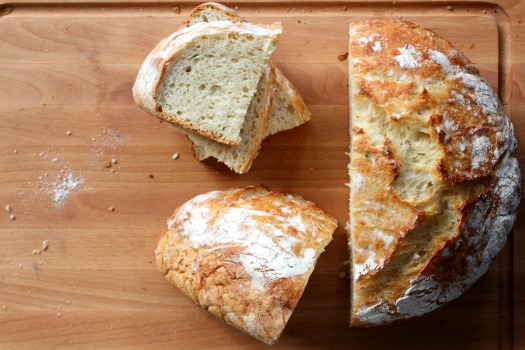
This bread is best the first 2-3 days. I just store my leftover loaf inside the Dutch oven on the countertop. Using plastic wrap will soften the crust. Dry, leftover bread makes great bread crumbs, toast, French toast, or croutons!
Enjoy. And pat yourself on the back. You just baked an amazing loaf of bread!
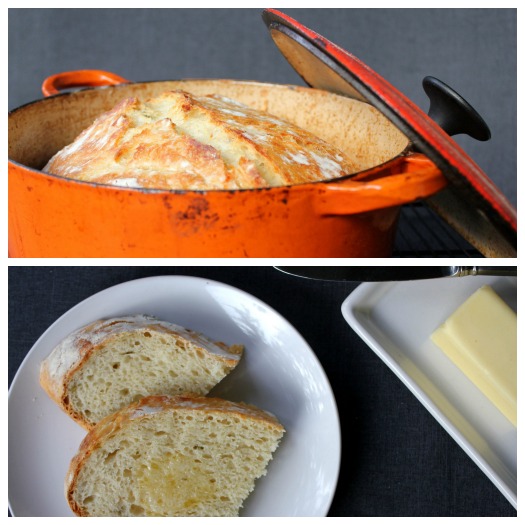
Basic No-Knead Bread
Slightly adapted from Jim Lahey’s My Bread
Ingredients
6 cups bread flour (recommended) or all-purpose flour, plus more for work surface
1/2 t. instant or active-dry yeast
2 1/2 t. salt
2 2/3 c. cool water
- In a large bowl, combine the flour, yeast, and salt. Add the water and stir until all the ingredients are well incorporated; the dough should be wet and sticky. Cover the bowl with plastic wrap. Let the dough rest 12-18 hours on the counter at room temperature. When surface of the risen dough has darkened slightly, smells yeasty, and is dotted with bubbles, it is ready.
- Lightly flour your hands and a work surface. Place dough on work surface and sprinkle with more flour. Fold the dough over on itself once or twice and, using floured fingers, tuck the dough underneath to form a rough ball.
- Place a full sheet/large rectangle of parchment paper on a cotton towel and dust it with enough flour, cornmeal, or wheat bran to prevent the dough from sticking to the parchment paper as it rises; place dough seam side down on the parchment paper and dust with more flour, cornmeal, or wheat bran. Pull the corners of parchment paper around the loaf, wrapping it completely. Do the same with the towel. Let rise for about 2 hours, until it has doubled in size.
- After about 1 1/2 hours, preheat oven to 425 degrees. Place a 6-8 quart heavy covered pot, such as a cast-iron Dutch oven, in the oven as it heats. When the dough has fully risen, carefully remove pot from oven. Unwrap the towel and parchment paper from around the dough and slide your hand under the bottom of the dough ball; flip the dough over into pot, seam side up. Pull the parchment paper off, scraping any stuck dough into the pan. Shake pan once or twice if dough looks unevenly distributed; it will straighten out as it bakes.
- Cover and bake for 40 minutes. Uncover and continue baking for 10-15 more minutes, until the crust is a deep chestnut brown. The internal temperature of the bread should be around 200 degrees. You can check this with a meat thermometer, if desired.
- Remove the bread from the pot and let it cool completely on a wire rack before slicing.
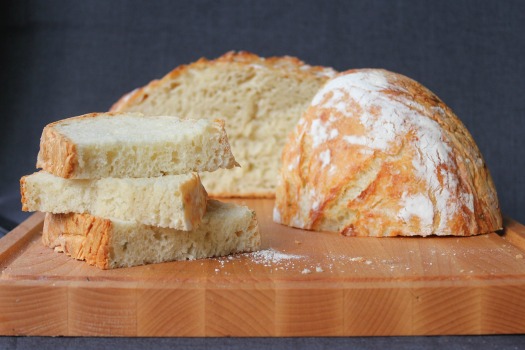
Here are a couple options for Dutch Ovens. Any heavy, lidded 5-8 quart pot (seasoned cast iron or enamel coated) would work with this recipe. Lodge has the best prices/options for dutch ovens on Amazon.
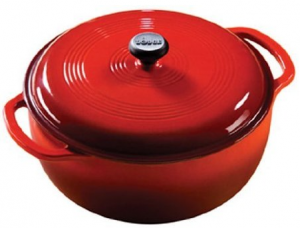
Lodge Logic Dutch Oven in Island Spice Red (6 Quart)
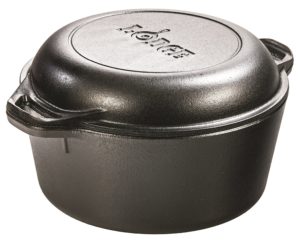
Lodge Cast Iron Double Dutch Oven (5 Quart)
If you already have a dutch oven (or find a deal on a lesser-known brand) that doesn’t have a knob rated for high temps, replace it! There are some really affordable options.
Got questions? You are in good company. Go here for the complete FAQ list.
Looking for more variations to the no-knead bread recipe? We’ve created a list with sweet and savory varieties, including the following:
- Cranberry Orange
- Four Cheese
- Sandwich Bread
- Dark Chocolate Coconut
- Tomato Basil Cheese
- Whole Wheat
Looking for more delicious bread recipes?
Find more delicious recipes on our Recipe Page!
Follow Frugal Living NW on Pinterest!
Fantastic range of boards from best recipes and tips for frugal living to gardening and budgeting help.
This post may contain affiliate links. See the disclosure policy for more information.
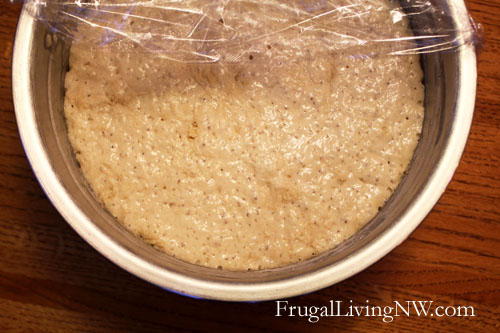
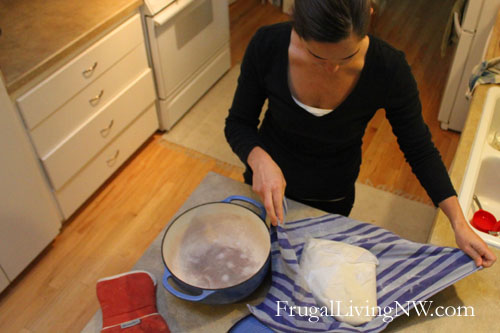
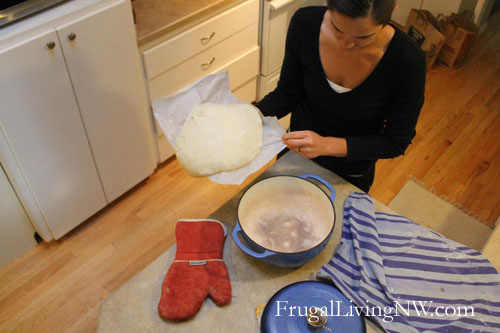

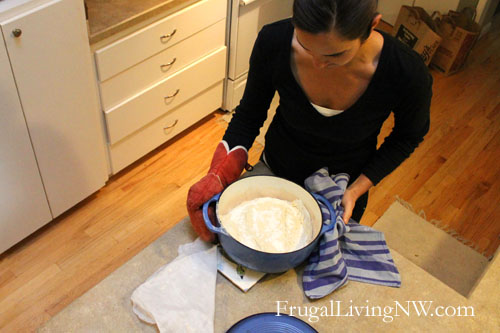
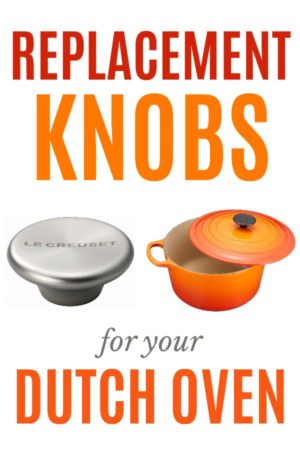

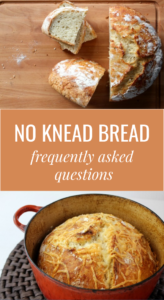
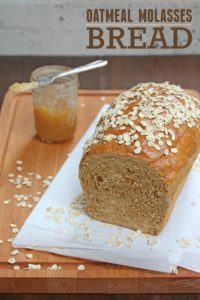
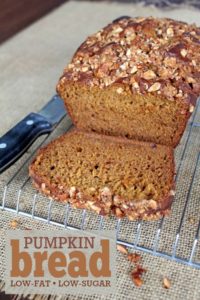
I deal with the awesome stickiness by adding 2tbs of olive oil with the first rise, Works every time and improves flavor.
I feel so capable thanks to your directions!!! I cut the recipe in half, but otherwise followed the directions exactly. What an amazing aroma there is coming out of my oven right now. Waiting to cut into that golden brown crust will be the only hard part.
Has anyone had luck making this with a little less salt? I’m on a low sodium diet and would like to HALVE the salt in the recipe but don’t know if it will drastically effect the rise…
No problem! It won’t affect the rise, just the flavor. We have had several comments from people cutting salt, or omitting it altogether. Some add herbs or other add-in for flavor (see FAQ page for some ideas).
made a loaf this weekend. followed the instructions exactly and it turned out perfect. the bread was really good. had a great crust and a nice inside.
ive never baked bread before and this was pretty simple. just some timing to be done and that’s about it.
i thought it could have been cut for sandwiches even had i wanted to. very impressed
Is the t. supposed to be tablespoon or teaspoon?
t. = teaspoon, T. = Tablespoon
It has risen almost to the top of bowl and has only been 8 hours. Lots of bubbles, I may try my luck and go to step two. Wish me luck!
Looks great! would i be able to split the recipe in half and bake it in a smaller, 3.5 quart pot. Would the cooking time or temperature vary if i split it?
Splitting the recipe (back down to the original size) works great! Check out our FAQ page for directions: http://www.frugallivingnw.com/frugal-homemaking/no-knead-bread-answers-to-faqs/
tried both half size and full size and it came out great. thanks for the recipe! Im trying every kind of variation now! (honey, molasses, herbs, etc)
Wow, this is amazing! I only had a four qt. dutch oven and it worked great!
I’ve made a variation of this bread a few times already. It’s a very forgiving loaf! When you think your doing it wrong.. You’re probably doing it right! Just go with it
Thank you for this post!! This looks delicious – I’m trying it as soon as possible… probably in a Dutch oven – been cooking in one for years and am convinced it holds some kind of cooking magic ju-ju. I’m starting a sourdough series next month on my blog, and hoping to come up with an equally easy “Artisan Bread” recipe using sour dough starter.
To add to the previous comment, and a capital “T” is tablespoon.
Hey I’m slightly confused. Is it half a teaspoon or half a tablespoon because it only has a t next to it? Please help trying to make this now
teaspoon
Good luck and enjoy!
Amazing to think bread is made with only four ingredients. I don’t have the cast iron pot but am going To get one and try this recipe.
Interesting note that 2 days ago our newspaper ran a lengthy story about this type of pot. There is a group that cooks all sorts of foods in them. One man even owns 40 pots that he uses routinely to do demostation cooking on the weekends.
got this in the oven RIGHT now. Im so nervous. Never baked bread in my entire life but this seemed so easy….Kitchen is starting to smell good so hopefully I did something right. We shall see in a bit. Thanks so much for sharing your recipe.
How did it turn out? Hopefully delicious
have you ever tried making this in a real dutch oven- with briquettes? Do you think it would work?
Thanks
Lara — every summer we camp for a week in Maine. Last year we made this exact recipe every day. 1/3 coals on the bottom and 2/3 coals on the top. Every loaf was perfect and gobbled up.
I’ve made this recipe several times and found that if I wash out the bowl that it originally raised in then grease it and dust it with flour or oats, the dough doesn’t stick after the second rising. Much easier to get into the dutch oven and not nearly as messy.
Okay… I’ve got this resting and ready to bake tomorrow. My only concern is that I don’t have a heavy cast iron dutch oven. I ran out today to see if I could find one at a thrift store, but nothing was available. I finally purchased a new cast “aluminum” pot with a lid which juuust about fit the money I had in my pocket. I plan on seasoning this pot before using it tomorrow, but I’m wondering if this will “hurt” the bread.
Debbie – I have always heard that aluminum conducts heat quite differently than cast iron but have never cooked with it. I would not use the pan and thus be unable to return it until you hear definitively that it will work. I have used cast iron for this recipe but typically use a covered Pyrex casserole (I usually only make half the recipe and my dutch oven is quite large) and reduce the heat a bit (to 380 or 390). The two methods have been equally successful.
Debbie I have a nice deep cast iron frying pan I have been useing it for yrs for baking breads and scones and cakes works like a champ less expensive than the dutch oven~ just shareing hope it helps
Brenda
Hi I just made this and it sure didn’t turn out right. I triple checked that I used the proper ingredients/amounts and I did. It rose nicely but was extremely sticky…I kept adding flour until I could get it not to stick to the parchment. When it came time to put into my dutch oven it would not come off the parchment paper. Anyone have any ideas? I live in the high Desert in California, if that matters. I’m not a novice at baking bread.
Hi, Lisa! My dough is always slightly different, depending on humidity, temperature, flour, etc. Once you make this bread several times, you’ll start to get a feel for what it should look/feel like. The recipe is a great starting place, but I always need to add more flour or water, depending on the day. That said, my dough often sticks to the parchment, too. I just quickly scrape it off. Sometimes it looks a little funky but should still produce a delicious loaf of bread. To avoid that, try adding more flour or wheat germ. I hope you’ll try it again!
Lisa – I had the same problem, but now spray the parchment with a non-stick spray and then a light dusting of flour – it doesn’t stick at all
I made this a few weeks ago in my 4.5qt Lodge and the hubby said I could make it ANY Time! it was so delicious! I’m anxious to try the whole wheat molasses version tho, YUM!
All I can say is…..this is FANTASTIC! A HUGE hit!!! I just ordered the cookbook!!!
I began doing this about two years ago when the NY Times was all atwitter about the latest thing. It’s rilly super triffic fantabulous BUT…
Maybe you are supposed to just know this, I have never seen it referenced anywhere, the 12 – 20 hours spent rising MUST take place in a climate controlled area. In the Winter my home averages about 52°F. That is not warm enough for the yeast to do its work ! The bread is edible, but it’s very much like unleavened bread !
In the PNW that can be quite problematic.
I used to make a lot of bread until our family all got too fat. This does sound like a winner.
I have something I have been wondering about for a long time. Why do so many recipes say “cover with a clean cloth”? I don’t imagine many cooks or bakers would cover with a dirty cloth.
Made a loaf tonight for a birthday dinner. Incredible! And super easy to make. Thanks!
Congratulations!
Your recipe is featured on Full Plate Thursday this week. Have a great week and enjoy your new Red Plate!
Miz Helen
I’m having a little trouble. When I make a fairly damp dough (not even “wet”) and put it on the board for the second rising, it spreads out so flat, I do not have any lidded contained I can bake it in. I don’t want a flat bread, i want a nice tall one like you have. When I let it do the second rising in a bowl so it stays high, I have trouble “turning it out” into the dutch oven–it sticks and has to be scraped, so it falls in on itself. Can you help?
I use parchment paper dusted with flour. That seems to do the trick.
when I used parchment paper, even floured, it stuck like crazy and I ended up having to pick pieces out of it, causing a deformed albeit delicious loaf. I’ve been using a good quality all cotton dish towel heavily flowered. It works really well.
Just made my first loaf of bread using this method and it was a great success!!! Thank you for the fantastic instructions. The difficulty was being patient while I waited for it to prove, bake and then cool. Couldn’t wait for it to cool completely before slicing it open and smothering it in butter and jam mmmm!!!
I don’t buy bread from the supermarket but my favorite artisan bread maker “Iggy’s bread” costs $7 a small loaf here in Sydney, Australia
Will be making my own for a fraction of the cost from now on :))
My dough is resting for the 12-18 hours right as I type.
I look forward to baking this tomorrow! I know it will be perfect.
Thank you so much for posting this.
Wow! I LOVE homemade bread. This looks wonderful. Thanks for sharing at Pinworthy Projects.
I have been making this bread for a few months now and we absolutely love it. Recently the dough does not rise at all like it should in the 12-18 hours and again no rise during the 2 hours. I live in FL my air is always on and set at the same temp but it is not hotter and more humid outside. Any ideas/suggestions, I would greatly appreciate it, we are going a little nuts with no bread. I don’t even buy store bread. Hahaha
Might your yeast have expired or been killed?
What a gorgeous loaf of bread! Thanks for linking up with What’s Cookin’ Wednesday!
Am not getting the bubbles on the bread after the 12-18 hours. I’ve made this bread a lot, and used to get them all the time, but now!! “Nothing”. Using same measurements as before.. Can it be temp
Bread is my weakness, this looks awesome! Thank you so much for sharing with Full Plate Thursday and have a fabulous weekend.
Come Back Soon!
Miz Helen
Hi.
First off: thank you so much for sharing this recipe and making such a detailed tutorial!
I’ve made this bread several times. My friends are crazy about it!
Our question is: do you have any experience making half loaves? I’d like to try it out, but am not sure how I’d adjust the baking time.
We’d love to make rolls. Everyone thinks this would be the perfect bread for soup rolls. Do you have any idea how we could do this?
Thank you so much for considering my questions!
Bella,
This recipe has been doubled. The original recipe can be found at http://www.nytimes.com/2006/11/08/dining/081mrex.html
Todd
Thank you for that! I will have to test it out in the smaller recipe.
Do you have any experience making them as rolls? Cause that’s what we are really all interested in over here. Hehe.
I have made this bread and variations at least a doz times now. When I taught my mom this recipe, she said, “wow, there is nothing in it.” So now our family has dubbed it the “nothing bread.” It really is the easiest recipe and tastes like a loaf you get at a fancy restaurant.
Hi!!
I baked the bread yesterday evening, and it was soooo gooood!!! Thank you for the recipe, I will surely use it again and again!!
Instead of a dutch oven, could you simply use a bread pan for a more uniform loaf shape? I’m curious about trying this recipe but would like to use a loaf pan instead of dutch oven.
No, a regular bread pan won’t work. You need a heavy pan with a good lid. Part of what makes the recipe work is that it’s a very wet dough. So, when you put it in the heavy lidded pot, you end up having steam form inside the pot. A regular loaf pan won’t allow the steam to develop.
If I cut this recipe in half about how long would I bake it for?
would love to cook in camp oven using briquettes.
believe 5 briquettes under and 14 on top would be enough and pushing the briquettes to the center of the top for the last 15 mins should brown the top.
value your opinion
regards
peter
i made this bread twice. the first time was a little plain and dense. the second time, i let the dough rise for longer and the taste was better but still dense. i used regular AP flour both times. i bought bread flour to try next time. could this be why? i prefer a lighter bread (with the crunchy outside) like a ciabatta
please help!
I <3 bread!
i made this bread twice. the first time was a little plain and dense. the second time, i let the dough rise for longer and the taste was better but still dense. i used regular AP flour both times. i bought bread flour to try next time. could this be why? i prefer a lighter bread (with the crunchy outside) like a ciabatta
I’ve been making this bread for years to take to our contra dance potlucks, and experimented with it to make it much simpler. The ingredients I use include two cups of AP flour and one cup whole wheat flour–with a heaping teaspoon of garlic salt for extra flavor. (The original NY Times recipe was only 3 cups of flour and about 1.5 cups water.) My pot is about a two or three quart oval cast iron with lid that I found at a thrift store for 25 CENTS! (I also discovered that a two quart cast iron sauce pan with lid works great for a round loaf.)
As to the second rising step–fergedaboudit. I mix the dough on Friday night (hint: cover the bowl with a motel shower cap), then just before I head for the shower on Saturday afternoon, I pre-heat the oven to 450 (with lid in the oven but off the pan), then I use a flour sifter to sprinkle a ring of flour around the inside of the bowl full of moist sticky dough. Then I use a rubber spatula to scrape the dough away from the edge of the bowl–which causes the flour to coat the dough. Turning the bowl, I work the spatula around the entire ball of dough and around the bottom so that I have a ball of very soft dough lightly coated with flour. I then open the oven, slide out the rack with the very hot pot on it–and then I continue working the dough with the spatula (so it’s not sticking to the bowl) as I dump it into the center of the pot. (NOTE: my hands never touch the dough!) Then on goes the lid, close the oven, set the timer for 25 minutes, and I hit the shower. After 25 minutes, I remove the lid and let it brown for another five minutes or so, then I dump the hot loaf onto a cooling rack for a few minutes while I finish getting ready. I then slide it into a brown paper lunch bag and off I go to the potluck. When I arrive it’s still warm–and warmly received–by my dance friends who have come to depend on my fresh bread at every potluck.
To the several comments that the bread did not increase in size during the first rising; this might be a failure of anticipation rather than the yeast. I have made this over a half dozen times and it has never increased in size by more than 20 percent – unlike the 5-Minute Artisan Bread which sometimes triples (then falls). It does get darker, bubbly, and smells very yeasty. Still, it has always been fantastic.